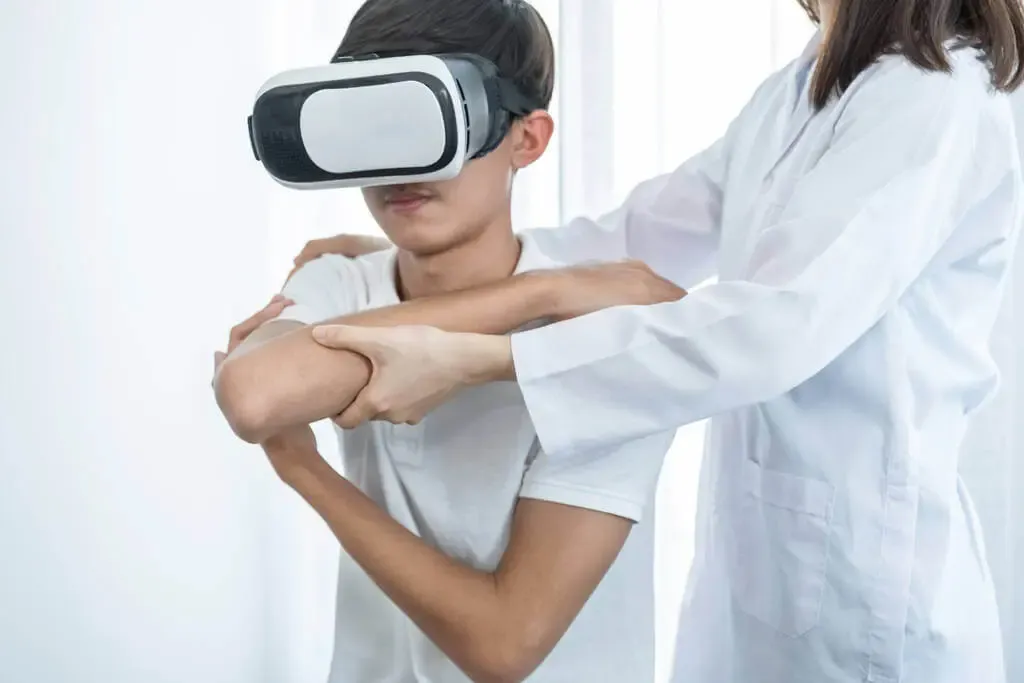Introduction
Living with chronic pain is a daily battle that millions of people around the world face. The constant discomfort, both physical and emotional, can have a profound impact on one’s quality of life. Traditional pain management approaches often fall short in providing lasting relief. However, a ray of hope has emerged in the form of virtual reality (VR) technology.
This immersive and captivating technology has shown promising results in alleviating chronic pain, offering a new avenue of hope for those seeking relief from their persistent discomfort.
Understanding Chronic Pain
Chronic pain, unlike its fleeting counterpart, acute pain, is a persistent condition that can last for weeks, months, or even years. It’s not just a physical sensation; it’s a complex blend of sensory, emotional, and cognitive experiences.
Individuals grappling with chronic pain often find themselves trapped in a cycle of distress, as the constant discomfort affects their mood, sleep, and overall well-being. The limitations of traditional pain management methods, such as medication and physical therapy, have led researchers and clinicians to explore alternative approaches.

The Science Behind VR’s Pain-Relieving Effects
The science behind using virtual reality for chronic pain relief is as fascinating as it is effective. To comprehend how VR can alleviate chronic pain, we delve into the intricate workings of neuroscience.
Chronic pain perception is not solely tied to the physical injury; rather, it’s a complex brain-generated response influenced by various factors, including attention, emotions, and past experiences. This is where virtual reality steps in with its unique ability to modulate this intricate response system.
The concept is simple yet profound: by immersing individuals in captivating virtual experiences, VR can effectively redirect their attention away from the incessant pain signals. The brain, in its captivating virtual world, dedicates its cognitive resources to processing the virtual environment, leaving fewer resources available to process the distressing pain signals. This cognitive diversion can lead to a remarkable reduction in the brain’s perception of pain intensity.

This phenomenon finds support in research conducted by Dr. Mitchell, a respected neuroscientist at a prominent research institution. “Our brain operates with finite processing capacity,” explains Dr. Mitchell. “When individuals engage in a virtual reality experience, the brain allocates its resources to that simulated environment, leaving less capacity to process the chronic pain signals. This cognitive shift is often associated with a noticeable reduction in the perceived intensity of pain.”
The immersive nature of virtual reality triggers a series of responses within the brain. Distinct areas responsible for processing pain, such as the anterior cingulate cortex and the insular cortex, exhibit reduced activity when the brain is engrossed in a virtual environment. This physiological response corresponds with individuals reporting lower pain intensity and improved pain tolerance.
The power of distraction has been harnessed for centuries to manage pain, but virtual reality takes this concept to an entirely new level. By engaging multiple senses and captivating the mind with its immersive experiences, VR provides a multi-pronged approach to pain management. Whether someone is battling chronic lower back pain, neuropathic pain, or even the lingering discomfort after surgery, virtual reality offers a captivating reprieve from the persistent distress.
As technology advances, researchers are diving deeper into the intricate neural pathways that virtual reality stimulates. This deeper understanding holds the potential to enhance the effectiveness of virtual reality as a chronic pain management tool. The collaboration between neuroscientists, healthcare providers, and technology experts is paving the way for a more refined and targeted approach to using virtual reality for chronic pain relief.
In the realm of chronic pain management, virtual reality is not just an escape into a simulated world; it’s a journey into the intricate workings of the brain, a journey that offers real relief to those who have long sought respite from the clutches of unrelenting pain.
Applications of Virtual Reality for Chronic Pain Management
The applications of virtual reality for chronic pain management are as diverse as the conditions it aims to alleviate. This innovative technology isn’t a one-size-fits-all solution; rather, it’s a versatile tool that can be tailored to suit individual preferences and pain profiles.
Immersive Environments
Imagine being transported to a serene beach, surrounded by the soothing sound of waves and a gentle breeze. Immersive environments like these are designed to create a sense of calm and tranquility, helping individuals shift their focus away from their chronic pain. By engaging multiple senses, virtual reality creates a sensory-rich experience that effectively distracts the mind from discomfort.
Interactive Distractions
Virtual reality offers more than just passive immersion; it introduces interactive elements that encourage both physical and mental engagement. Engaging in a virtual game, solving puzzles, or participating in simulated activities not only diverts attention but also triggers the brain’s reward centers, releasing endorphins that naturally alleviate pain.
Guided Meditations
Mindfulness and relaxation techniques have long been employed in pain management. Virtual reality takes these techniques to new heights by providing guided meditation experiences set in captivating environments. Individuals can embark on a virtual journey of introspection and relaxation, effectively reducing stress and thereby lessening pain perception.
Personalized Pain Management
One of the remarkable aspects of virtual reality for chronic pain is its adaptability. Virtual reality experiences can be tailored to address specific pain conditions. For instance, someone dealing with chronic migraines might benefit from a virtual environment that promotes relaxation and dim lighting, while an individual recovering from surgery could find comfort in an immersive distraction during wound care.

Empowering Personal Anecdote
I spoke with David, who had been enduring chronic joint pain for years. His virtual reality journey started with skepticism, but it soon became a cornerstone of his pain management routine. “The interactive VR experiences gave me a sense of control over my body that I hadn’t felt in years,” David shared. “It allowed me to move, albeit virtually, without the fear of pain. And over time, this newfound confidence translated into my physical reality.”
I also spoke to John, a veteran who had sustained chronic back pain due to a combat-related injury. He shared how VR therapy not only helped manage his pain but also provided a sense of empowerment. “In the VR world, I could do things I couldn’t in reality,” John said. “It made me feel in control again, even if it was just virtually. And that sense of control reduced my perception of pain.”
As research into the efficacy of virtual reality for chronic pain management deepens, healthcare providers are exploring ways to integrate this technology into mainstream treatment plans. The concept of virtual reality as a tool for pain relief is no longer confined to research labs; it’s becoming a tangible and accessible solution that holds promise for transforming the lives of those grappling with persistent discomfort.
Benefits of Using Virtual Reality for Chronic Pain Management
The benefits of using virtual reality for chronic pain management extend beyond its captivating immersive experiences. This innovative approach holds several advantages over traditional pain management techniques, making it a promising solution for those seeking relief from persistent discomfort.
Drug-Free Pain Relief
Traditional pain management often involves the use of medications, which can lead to undesirable side effects and the risk of dependence. Virtual reality offers a drug-free alternative that doesn’t introduce foreign substances into the body. By tapping into the brain’s natural ability to modulate pain perception, virtual reality provides relief without the potential drawbacks of pharmaceutical interventions.
Enhanced Patient Engagement
Chronic pain management requires active participation and engagement from individuals. Virtual reality excels in this aspect by offering engaging and interactive experiences. Whether navigating through a virtual world or participating in an interactive game, individuals are more likely to remain engaged in their pain management regimen, increasing the overall effectiveness of the approach.
Holistic Pain Management
Chronic pain isn’t just a physical sensation; it often has emotional and psychological components. Virtual reality addresses this holistic nature of pain by engaging both body and mind. The captivating environments and interactive distractions not only divert attention from pain signals but also promote relaxation, reduce stress, and enhance overall well-being.

Personalized Approach
Virtual reality for chronic pain isn’t a one-size-fits-all solution. Its adaptability allows healthcare providers to tailor experiences to suit individual preferences and pain conditions. This personalized approach ensures that each individual’s unique pain profile is taken into account, enhancing the likelihood of successful pain relief.
Fostering a Sense of Control
Chronic pain can make individuals feel helpless and out of control. Virtual reality has the power to change that narrative. Through virtual environments and interactive simulations, individuals can experience a sense of agency and control over their bodies, even if it’s within a simulated realm. This newfound confidence often translates into real-life pain management strategies.
Real-World Success Stories
The tangible benefits of virtual reality for chronic pain relief are exemplified in the stories of individuals like Emma, who had been living with fibromyalgia for years. Traditional treatments offered limited relief, but VR therapy introduced her to a new world of possibilities. “The virtual reality experiences not only distracted me from the pain but also allowed me to engage in activities I thought were impossible,” Emma revealed. “This technology gave me hope and helped me regain a sense of normalcy.”
As virtual reality gains traction as a viable chronic pain management solution, ongoing research continues to explore its full potential. However, it’s important to acknowledge that while virtual reality offers immense promise, challenges such as accessibility, cost, and technology integration still need to be addressed to ensure equitable access for all individuals seeking relief.
Ethical and Social Implications
While the promise of using virtual reality for chronic pain relief is exciting, it’s crucial to delve into the ethical and social considerations that come with integrating this innovative technology into mainstream healthcare practices.
The Human Element
A central concern revolves around the potential diminishing of the human element in healthcare. As virtual reality gains prominence, there’s a risk that the role of healthcare providers and the empathetic human touch might be overshadowed by the allure of technology. Striking the right balance between technological innovation and compassionate care remains a critical consideration.
Dependency on Technology
As virtual reality becomes an integral part of pain management, there’s a question of how much reliance on technology is too much. Overreliance on virtual reality could potentially detract from patients’ ability to develop their coping mechanisms and self-management strategies. Ensuring that virtual reality complements, rather than replaces, traditional approaches is a delicate balance to maintain.
Equitable Access
The accessibility of virtual reality technology is another pressing issue. While the potential benefits are evident, not everyone has equal access to this technology due to factors like cost, location, or technical proficiency. Ensuring that virtual reality solutions are accessible to a diverse range of individuals is essential to prevent exacerbating healthcare disparities.

Preserving the Human Connection
Virtual reality, by its very nature, immerses individuals in a simulated environment. While this can be beneficial for pain management, it also raises concerns about whether the genuine human connection between patients and healthcare providers might be compromised. Integrating virtual reality while preserving the trust and rapport between patients and providers requires thoughtful navigation.
Ethical Considerations
The integration of technology into healthcare also raises ethical questions. For instance, who holds the responsibility if a virtual reality intervention goes wrong? How can patient data privacy be ensured in virtual reality environments? Exploring these ethical considerations is imperative to maintain patient safety and ensure the responsible use of technology.
The growing use of virtual reality for chronic pain management brings these ethical and social implications to the forefront. Addressing these concerns requires collaborative efforts between technology developers, healthcare professionals, ethicists, and policymakers to ensure that the potential benefits of virtual reality are harnessed responsibly and equitably.
The Future of Virtual Reality for Chronic Pain Management
The landscape of chronic pain management is on the brink of transformation, thanks to the ever-evolving potential of virtual reality. As technology advances and our understanding of its impact deepens, the future holds exciting prospects for the integration of virtual reality into mainstream healthcare practices.
Advancements in VR Technology
As technology continues to evolve, so does the sophistication of virtual reality experiences. With improvements in visual fidelity, sound quality, and haptic feedback, virtual reality environments are becoming increasingly immersive and lifelike. This enhancement in sensory engagement can lead to even more effective distraction from chronic pain and a heightened sense of presence in the virtual world.

Tailoring Experiences
The future of virtual reality for chronic pain management lies in customization. Researchers are exploring ways to tailor virtual reality experiences to address specific pain conditions and individual preferences. By creating bespoke environments and interactions, healthcare providers can optimize the effectiveness of virtual reality interventions, ensuring that they resonate with each patient’s unique pain profile.
Integration with Cognitive Therapies
The intersection of virtual reality and cognitive therapies offers a promising avenue for chronic pain management. Integrating techniques like mindfulness and cognitive behavioral therapy with virtual reality experiences can provide a holistic approach to addressing both the physical and emotional aspects of pain. This fusion holds potential for enhancing pain relief and improving overall well-being.
Collaboration between Experts
The future success of virtual reality for chronic pain management hinges on interdisciplinary collaboration. Technological innovators, neuroscientists, healthcare providers, and ethicists must work together to refine and optimize virtual reality solutions. This collaborative effort ensures that the technology is not only effective but also ethically sound and accessible to all who can benefit from it.
Continued Research and Development
The journey of virtual reality for chronic pain management is far from over. Ongoing research and development are essential to uncover new insights into its mechanisms, refine its applications, and address any potential challenges. As the scientific community delves deeper into the neurological underpinnings of pain modulation through virtual reality, we can expect to unlock even more effective strategies.
A Brighter Future
As virtual reality continues to prove its mettle in chronic pain management, its future holds promise for individuals who have long sought relief from the burden of unending discomfort. Through its immersive experiences, distraction techniques, and the empowerment it offers, virtual reality is poised to become an integral part of mainstream pain management strategies.
As we look ahead, the fusion of technology and healthcare becomes increasingly intertwined, with virtual reality leading the charge in revolutionizing how we perceive and manage chronic pain. With every advancement and success story, the boundaries of possibility expand, offering new hope and improved well-being for chronic pain sufferers around the world.
Conclusion: A New Horizon for Chronic Pain Relief
In the realm of chronic pain management, where individuals grapple with the relentless burden of discomfort, virtual reality emerges as a ray of hope, illuminating a path toward relief and improved well-being. The convergence of technology and healthcare has birthed an innovative solution that offers more than distraction—it offers empowerment, engagement, and the potential for transformation.
Virtual reality for chronic pain management isn’t just about escaping into a simulated world; it’s about understanding the intricate workings of the brain and harnessing its remarkable ability to modulate pain perception. Through immersive environments, interactive distractions, and personalized experiences, virtual reality addresses the multidimensional nature of chronic pain, engaging both body and mind in the pursuit of relief.
The successes of individuals like Emma, John and David underscore the tangible benefits of virtual reality in alleviating chronic pain. These stories are testaments to the adaptability and potential of this technology, offering a glimpse into a future where the boundaries of possibility are expanded, and quality of life is enhanced.
As we navigate the path forward, it’s essential to tread carefully, acknowledging the ethical considerations and social implications that come hand in hand with integrating technology into healthcare. Ensuring equitable access, maintaining the human touch, and navigating the balance between technology and tradition are all critical as we embrace virtual reality as a tool for pain relief.
The journey doesn’t end here. With each advancement in virtual reality technology, each new understanding of its impact on the brain, and each collaboration between experts, the future of chronic pain management becomes increasingly promising. The horizon shines brighter as we move toward a future where virtual reality isn’t just a concept—it’s a tangible solution for those in need.
In the face of chronic pain, where darkness can often seem unyielding, virtual reality offers a beacon of light. It offers a chance to step into a world where the weight of pain is lifted, where possibilities are renewed, and where individuals can reclaim a sense of agency over their bodies and lives. As we step into this new era of pain management, one thing is clear: virtual reality is not just a tool; it’s a symbol of hope, resilience, and the potential for a brighter future.





